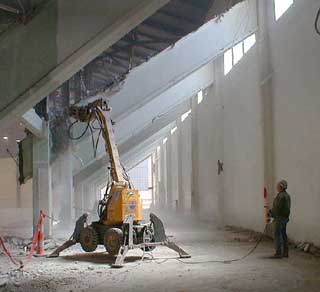|
Subscribe / Renew |
|
|
Contact Us |
|
| ► Subscribe to our Free Weekly Newsletter | |
| home | Welcome, sign in or click here to subscribe. | login |
Construction
| |
 |
November 2, 2000
Robots help with demolition
Nuprecon
On March 6, 1999, University of Washington fans watched their last basketball game in the original interior of the Hec Edmundson Pavilion. Soon after, the 18-month-long $39 million renovation began.

|
Nuprecon was responsible for all demolition (structural, mechanical, electrical, all interior partitions and finishes), abatement, cutting and capping of utilities, temporary lighting and electrical facilities, shoring and salvage. Nuprecon removed the support columns, and demolished the entire seating bowl and its supporting structure. The firm and its subcontractors also removed the running track, locker rooms, concession areas, ceilings and catwalks, and salvaged the basketball court.
Electrically powered remote-controlled robotics were used for overhead demolition beneath the seating bowl. The work surface surrounding the seating bowl could not support the weight of typical heavy equipment. The robotic equipment is much lighter but can perform demolition as efficiently. It is also emission-free, and safer for the operator.
The 1927 two-level-plus mezzanine presented a series of technical challenges. Nuprecon worked closely with Sellen Construction, the project's construction manager, to come up with innovative demolition techniques.
The inevitable complications were there: a partially operational facility, occupied areas nearby, live utilities, unusual hazardous materials and a high community profile. The historic brick exterior had to be preserved without a nick even though the inside was gutted to a shell.
The seating bowl posed the main technical problem. Twenty-two concrete columns with structural steel beams and 22 raker beams provided lateral support for the 60-foot high, unreinforced brick exterior walls. Removal meant extensive (and expensive) shoring to keep the historic walls from caving in. The Sellen-Nuprecon team devised a solution: retain the raker beams and horizontal ties until the supertrusses could be placed. This approach provided the necessary structural support and a cost-effective alternative to shoring.
A number of University functions housed within the Pavilion facility continued throughout the demolition process. Locker facilities for the Husky football team had to be maintained to accommodate spring training. The laundry room was in use throughout the entire course of demolition; water, electrical, heating and cooling were rerouted to keep it operational.
The seating bowl demolition involved removing a major concrete structure that supported high-voltage power lines and fiber-optic cables housed in 4-inch conduits suspended from the seating bowl. The fiber-optic cables were an integral part of the communication network for the entire campus. Nuprecon created a shoring system that supported and protected the conduits while demolition was under way.
Unique hazardous materials demanded further creativity. The ground floor had 55,000 square feet of mercury-laden flooring held down with mastic that contained asbestos. The mastic behaved like a sticky, rubberized cement, tending to re-adhere to the flooring even after the flooring was separated from the slab.
In response, Nuprecon invented a mercury flooring abatement process. That meant getting approval for innovative work practices from the Department of Labor and Industries, Puget Sound Air Pollution Control Authority, and the University of Washington. Nuprecon self-performed the mercury flooring abatement, coordinating with one subcontractor to remove the mastic, and another to dispose of the hazardous waste. The abatement work was scheduled on swing shifts so that demolition and utilities relocation could continue during the day. The overall process proved safe and effective. According to Darryl Nestor, Sellen’s superintendent, "they [Nuprecon] had a large amount of material to remove in a short time, but they did it on schedule."
Nuprecon recycled all concrete and masonry, as well as steel, scrap metals and wood products. Casework and floor coverings were salvaged for reuse. The arena seating, windows, catwalks and lighting fixtures will live to see another day in the renovated facility. Nuprecon estimates 75-80 percent of the demolished materials were recycled. The company continues to consult with Sellen’s Sustainable Construction Manager, Lynne Barker, on ways to increase recycling and salvage on future projects.
Susan Cannon is vice president of planning and development at Nuprecon, a Redmond-based demolition contractor.
Other Stories:
- Who the heck is Hec?
- Rehabbed arena is designed for the future while still respecting the past
- UW's Hec Ed is ready for another 75-year run
- Universities spend big to earn more


